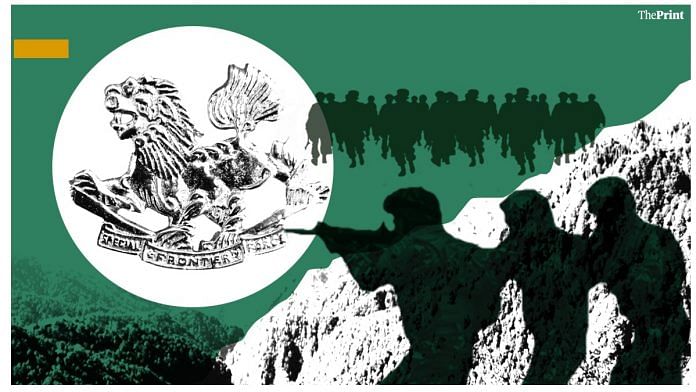New Delhi: The Special Frontier Force (SFF) or Establishment-22, a ‘secret’ paramilitary unit that has been part of numerous key operations, albeit usually from the shadows, marks 60 years of its formation today.
The elite covert force, which reports not to the Indian Army but directly to the Cabinet Secretariat and the Prime Minister’s Office, was formed on 14 November, 1962, a week before China declared a unilateral ceasefire during its war with India that year.
Mainly comprising Tibetans in-exile and Nepali Gurkhas, the unit became known for its mountain warfare skills and went on to secretly serve in highly sensitive military operations such as Operation Eagle (Chittagong Hills, 1971 India-Pakistan War), Operation Bluestar (Golden Temple, 1984), Operation Meghdoot (Siachen, 1984), and Operation Vijay (Kargil, 1999).
In 2020, however, the smokescreen surrounding the unit was momentarily cleared away when SFF company leader Nyima Tenzin died amid the India-China standoff at the Line of Actual Control (LAC) in Ladakh.
BJP leader Ram Madhav had attended the soldier’s funeral in September that year, only to delete his tweet about the event shortly after.
Author and historian Claude Arpi has hinted that there could be a link between the SFF and former Indian Prime Minister Jawaharlal Nehru, whose birthday also falls on 14 November.
“For most Indians, November 14 means the birthday of Jawaharlal Nehru, but there is also another anniversary, albeit an ‘uncelebrated’ one, falling on the same day… There might have been an invisible link between the two ‘birthdays’, but we will possibly never know why the formation of the Tibetan Army was initiated on November 14,” wrote Arpi in a blog post Monday.
“Did BN Mullik, the then Director of the Intelligence Bureau or DIB (and one of the main culprits of the 1962 fiasco) want to please Nehru on his birthday by telling him that he ‘had found a solution’ to China’s military superiority? The Tibetans would themselves ‘liberate’ Tibet!” he further speculated.
Also read: Operation Eagle — The 1971 mission by RAW and Tibetan SFF that has no official record
Formation of SFF
As pointed out by author M.D. Sharma in his 2008 book Paramilitary Forces of India, Tibetans first started serving in India during British rule, and were initially recruited as spies, intelligence agents, and even covert militia.
After the Chinese invasion of Tibet in 1949, Sharma writes, the US Central Intelligence Agency (CIA) and the Intelligence Bureau (IB) in independent India established the Mustang Base in Nepal which trained Tibetans in “guerrilla warfare”.
The SFF regiment, formed towards the tail end of the 1962 India-China War, was similarly drawn from Tibetan refugees settled in India.
The unit is nicknamed ‘Establishment 22’, or simply the ‘Two Twos’, after its first Inspector General, Maj Gen Sujan Singh Uban, who had earlier served as commander of the 22 Mountain Brigade.
As noted earlier, although the force is led by Indian Army officers, it does not report to the Army but to the Cabinet.
The 1971 Bangladesh War was the first major task of the SFF, even though the official history of the war published by the Indian and Bangladeshi governments does not mention the Tibetan regiment in order to keep it secret.
In his memoirs, The Phantoms of Chittagong, Uban recalls preparing the SFF troops for the war and having them fight alongside the Mujib Bahini, the elite Bangladeshi force. He proposed conducting guerrilla operations in Bangladesh’s Chittagong Hills to counter Pakistani troops — an action which, according to him, General Sam Manekshaw, the then Indian Army chief, had been in favour of too.
“Our minds met and I set out to prepare this Special Force of Northern Hill Tribes (the Tibetans) for this new venture. Leaders and men of this force did not take much time to understand the full implication of joining this venture and they made a representation in writing that they should be allowed to participate and make some contribution if ever Pakistan forced this war on India,” Uban wrote.
Today, former SFF servicemen reside in Tibetan settlements across India — from Delhi’s Majnu ka Tilla to Karnataka’s Mundgod and Bylakuppe — and run small businesses like eateries or shops selling sports shoes, apparel and wholesale products.
“We were guerrillas back then,” Kunsang Youten, a former SFF soldier and now the public relations officer (PRO) of Majnu ka Tilla’s Residents Welfare Association in Delhi, told ThePrint in 2020.
Youten said that during his years of service from 1985-97, he patrolled critical areas along the LAC, like Chushul, Hot Springs, and Pangong Tso — names that have become familiar due to India’s LAC standoff with China.
(Edited by Nida Fatima Siddiqui)
Also read: Sam Manekshaw, the general who told Indira when Indian Army wasn’t ready for a war



